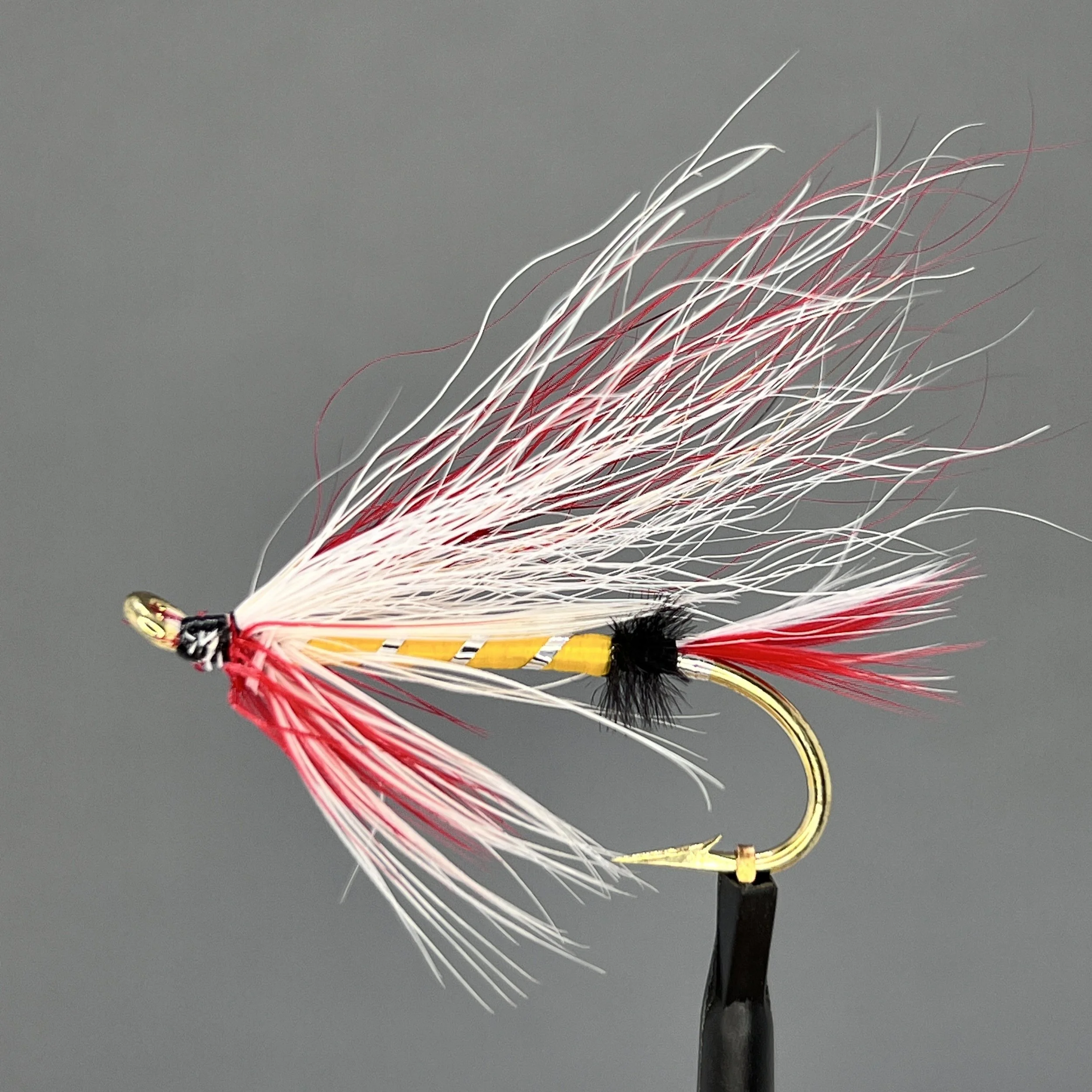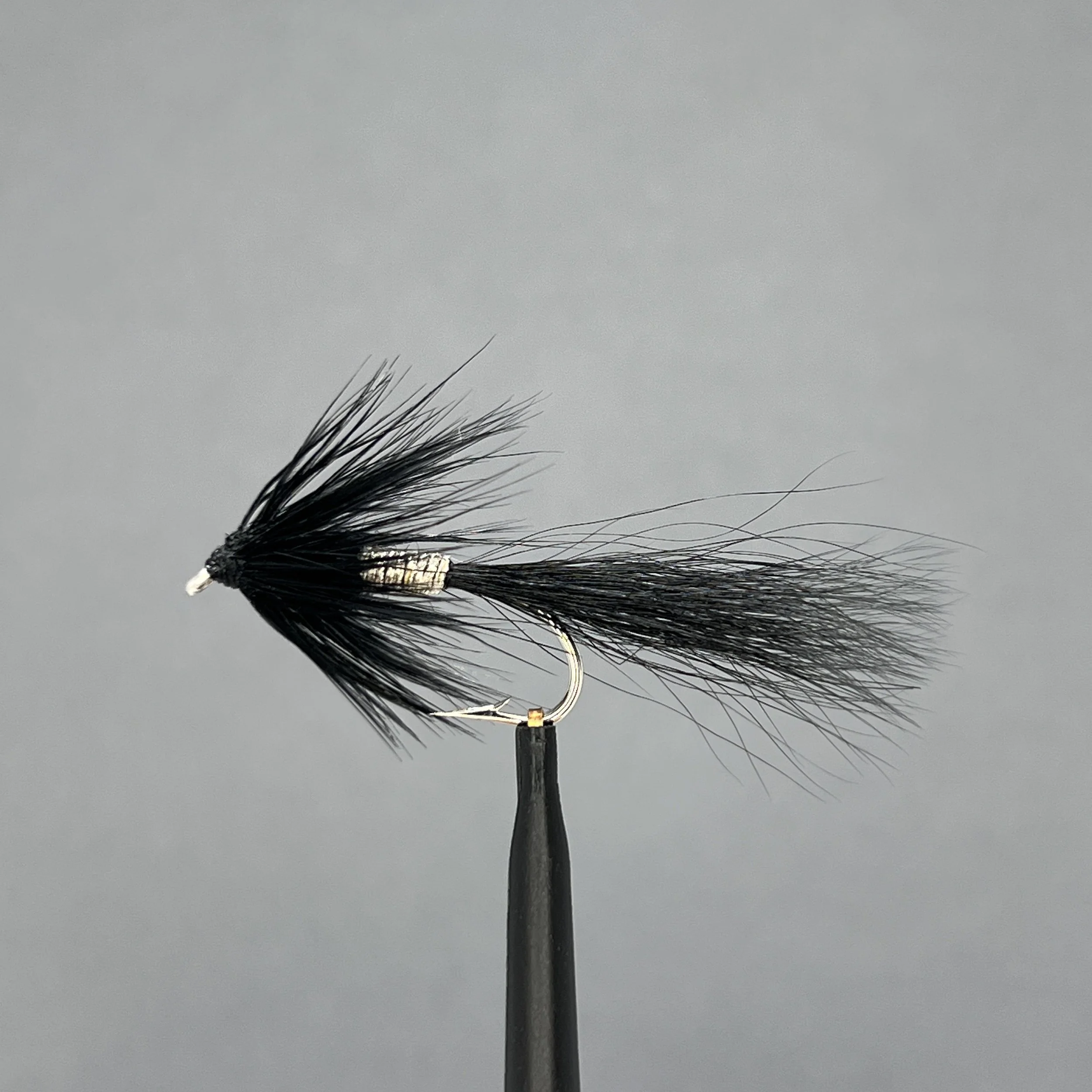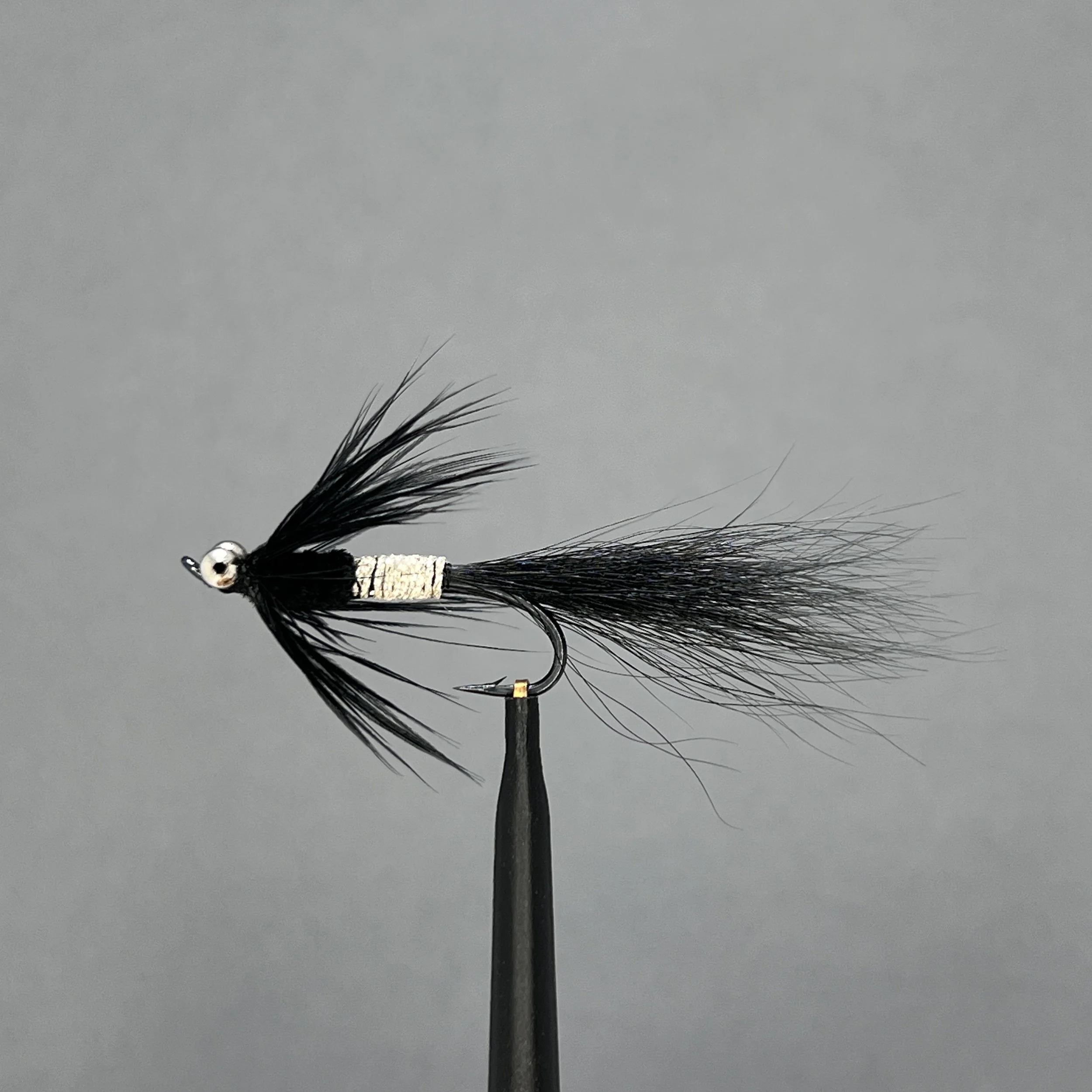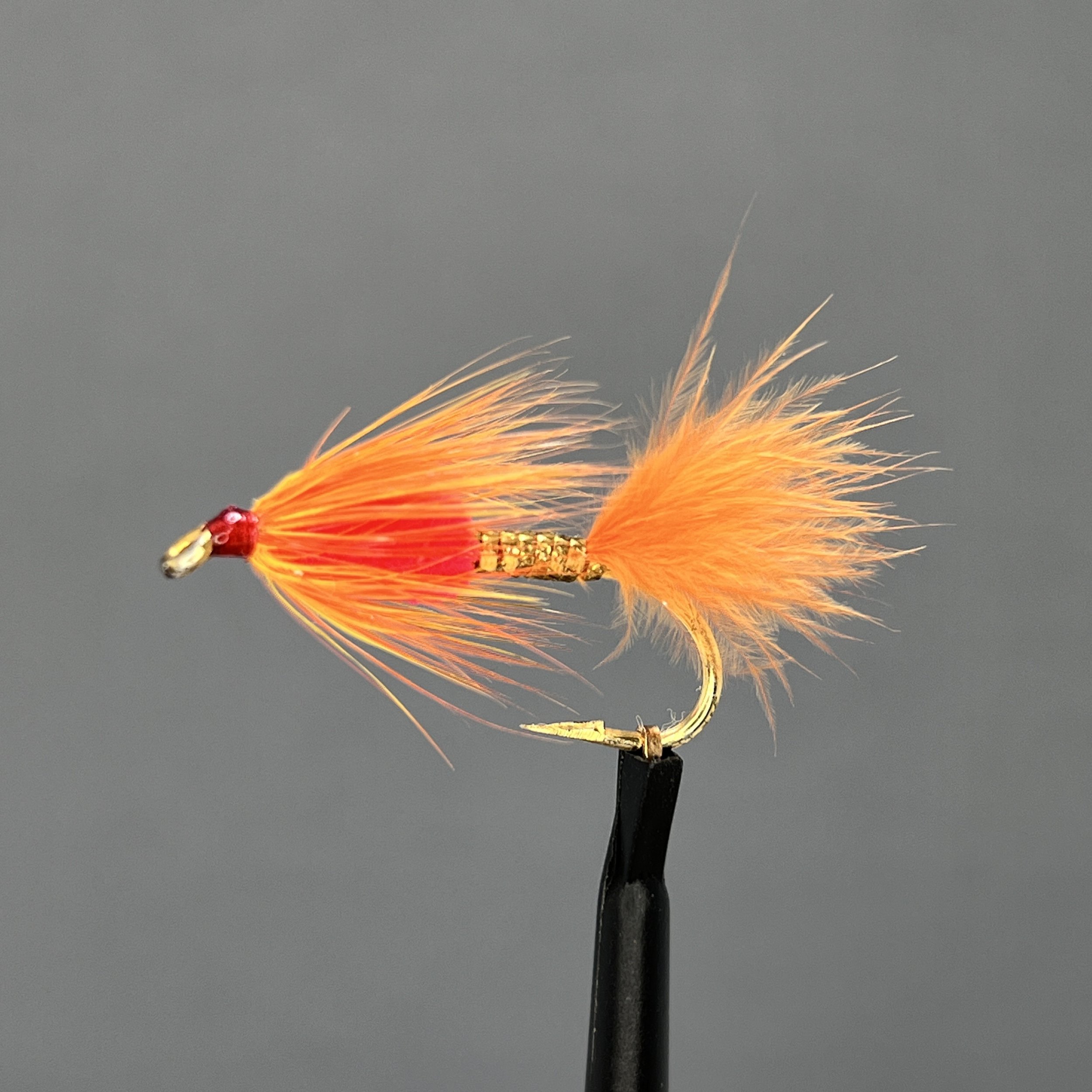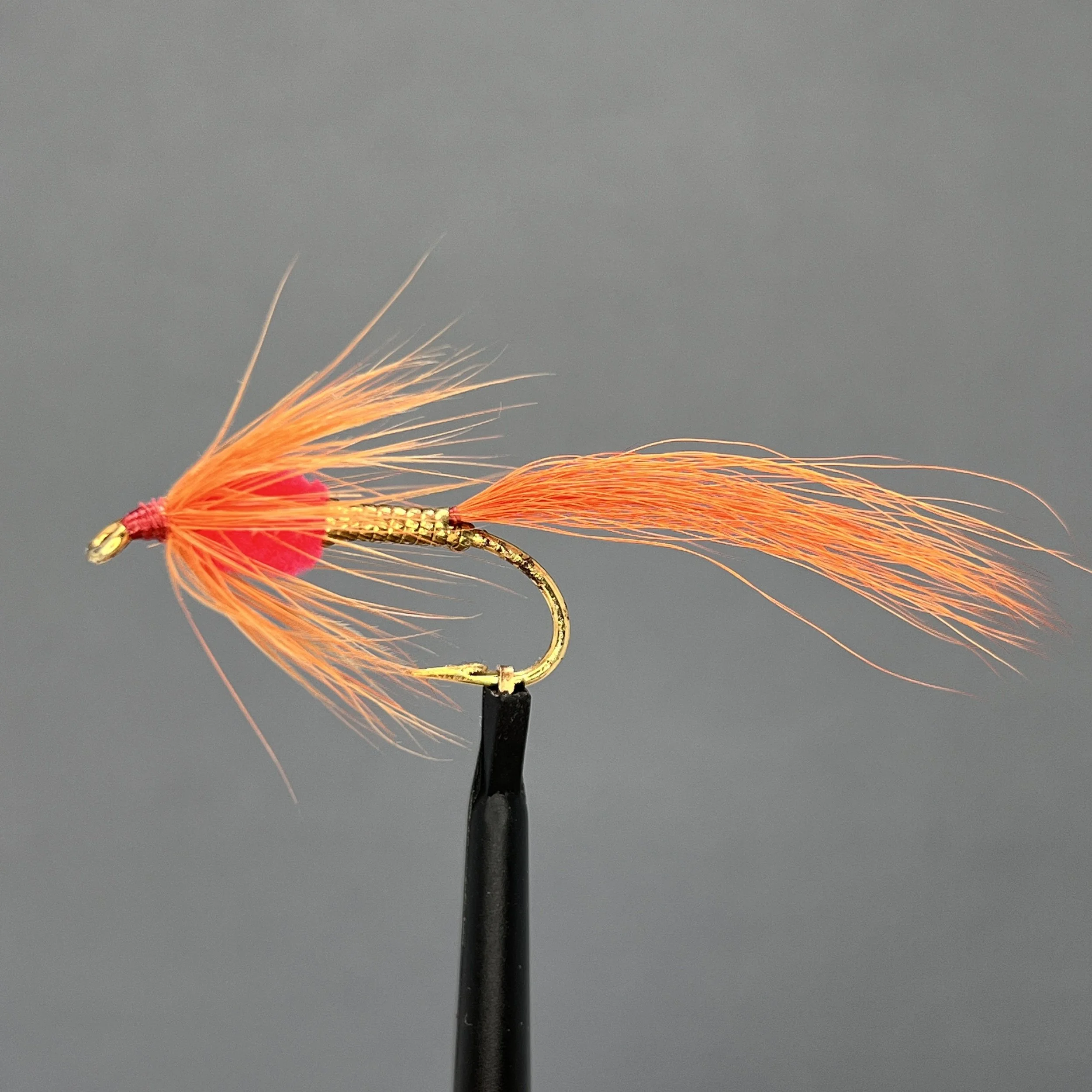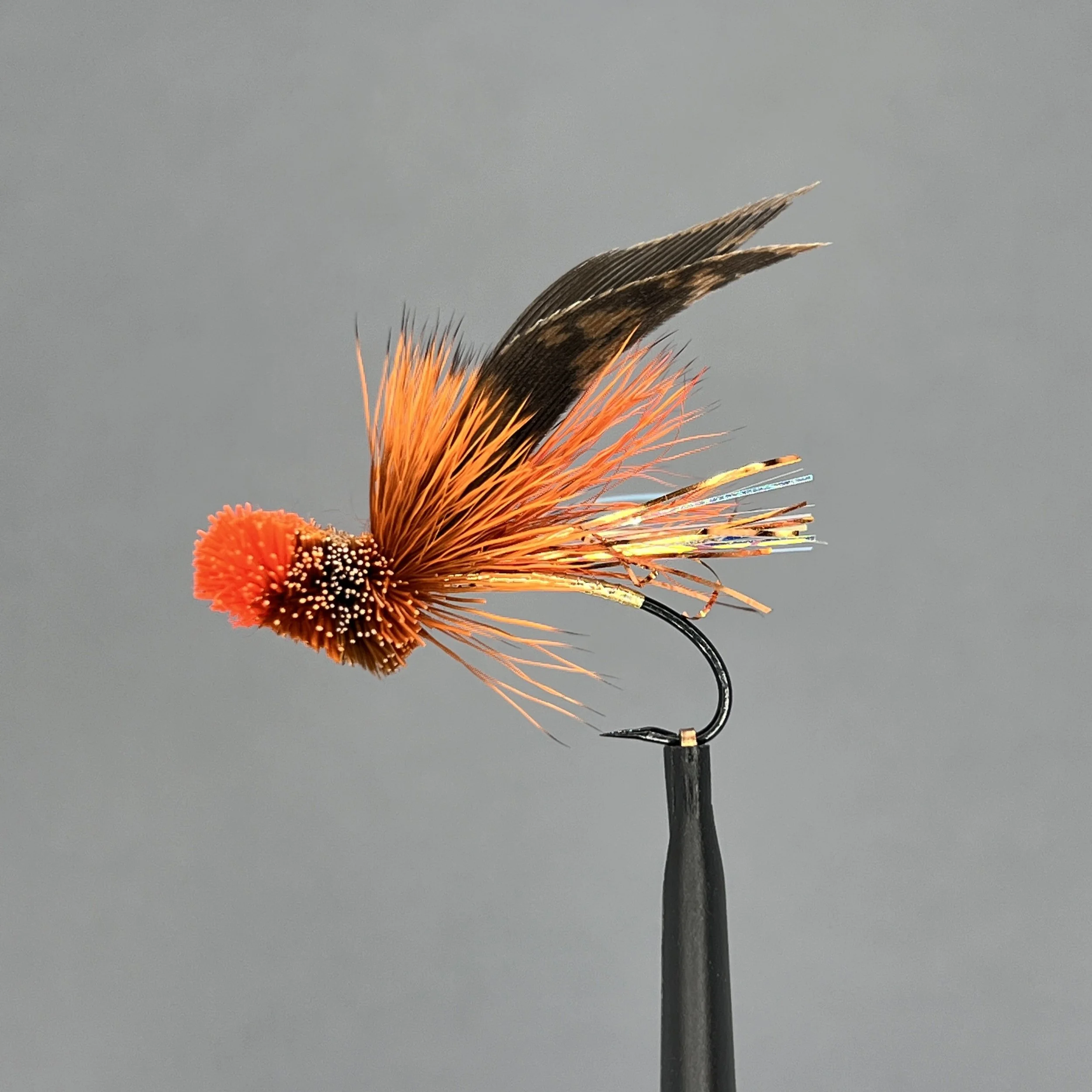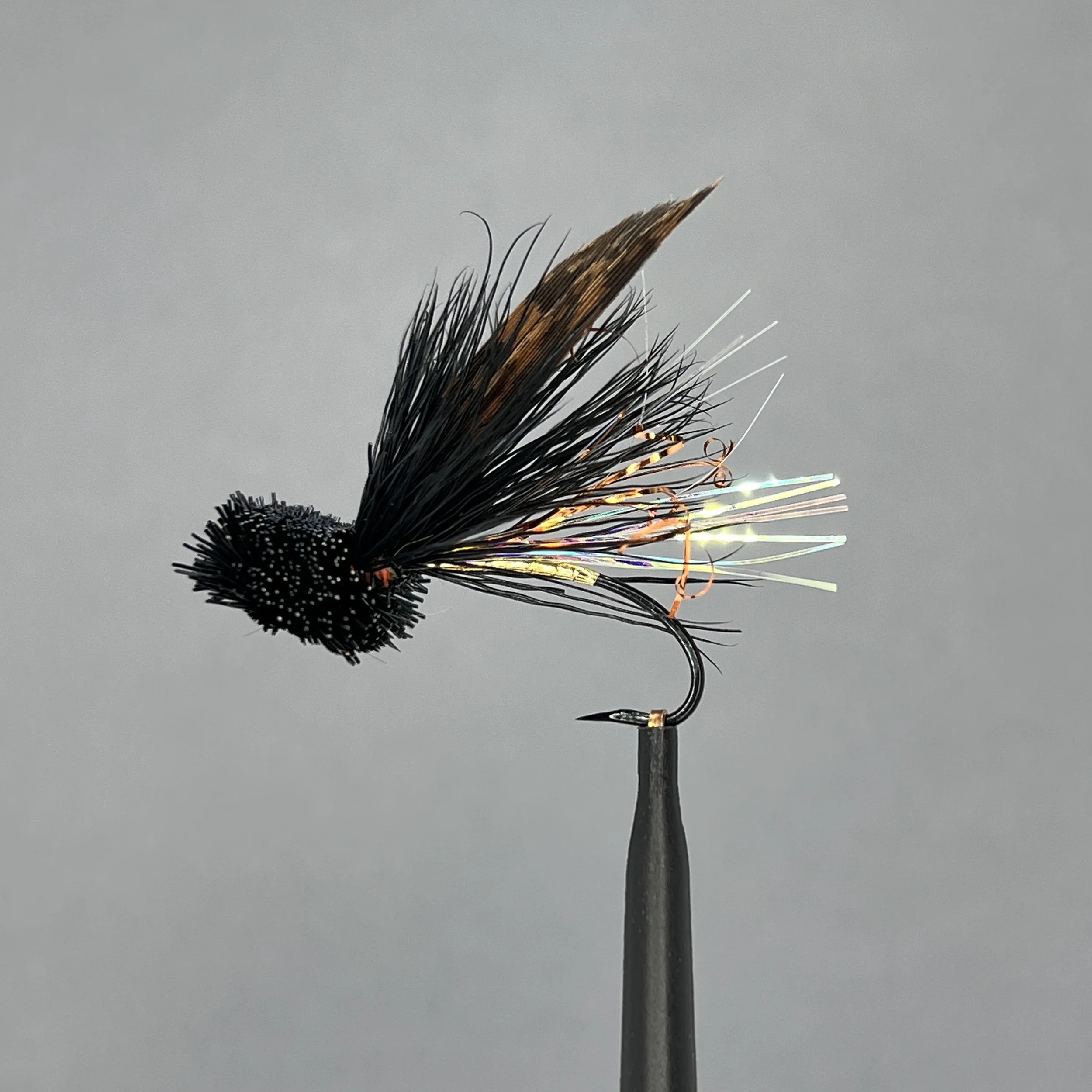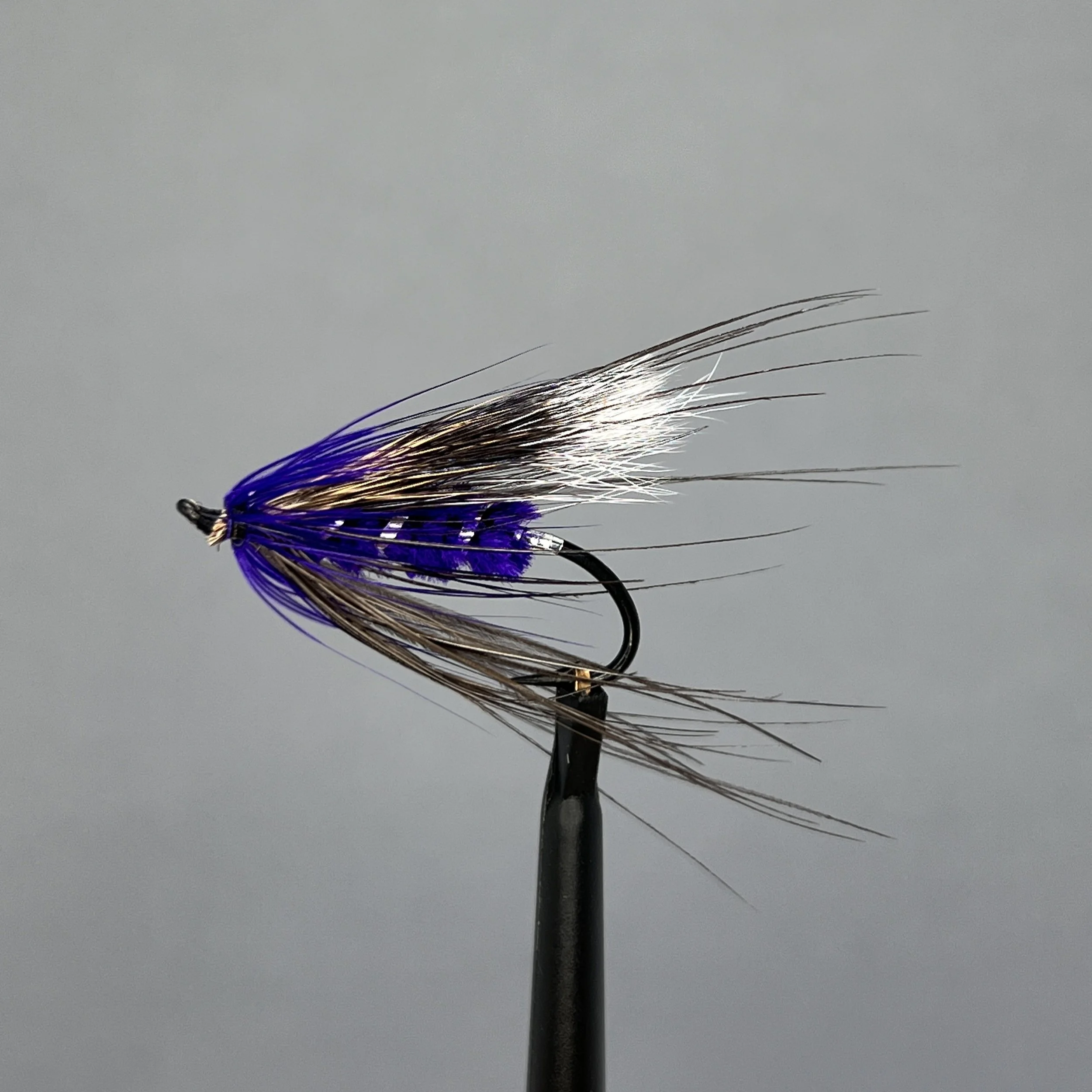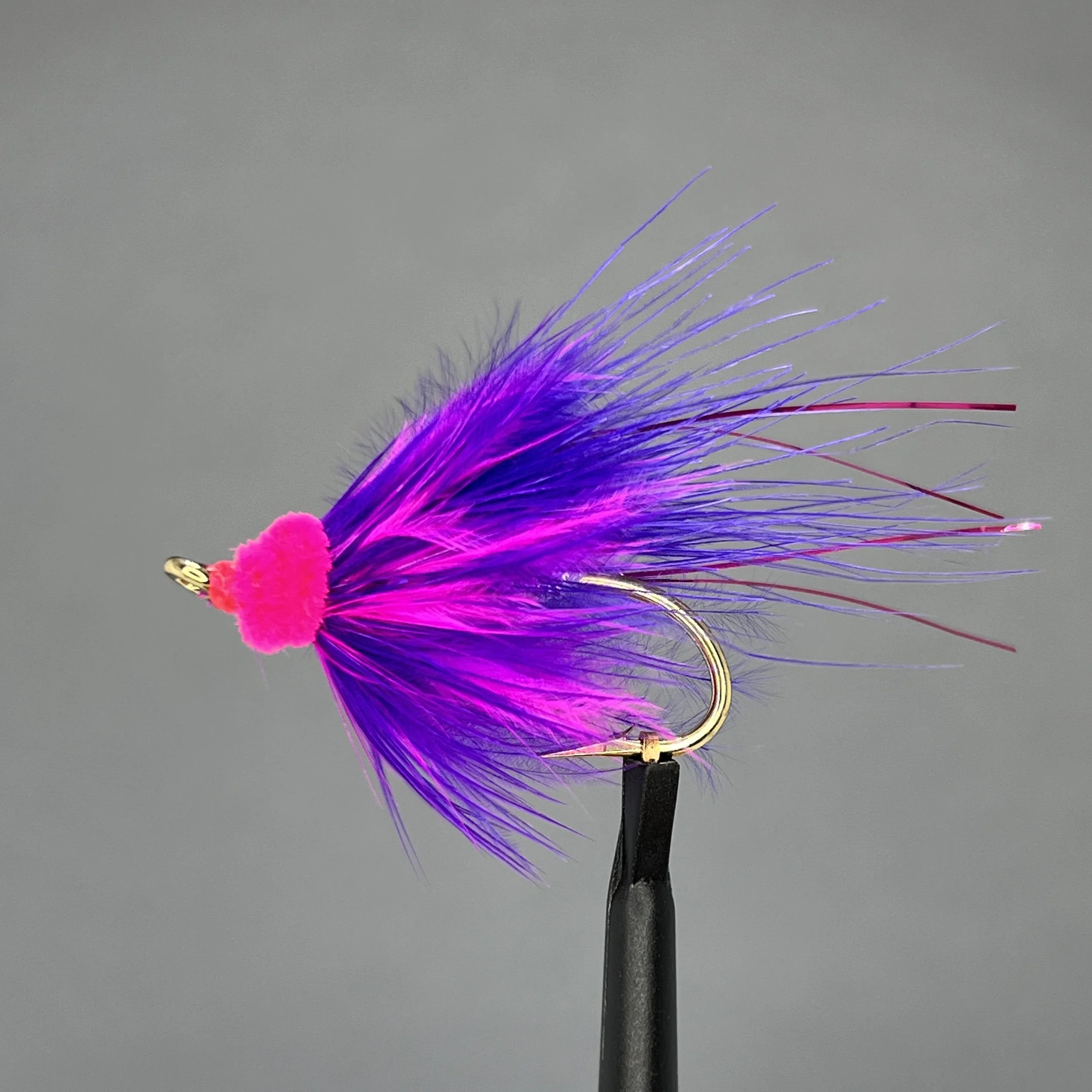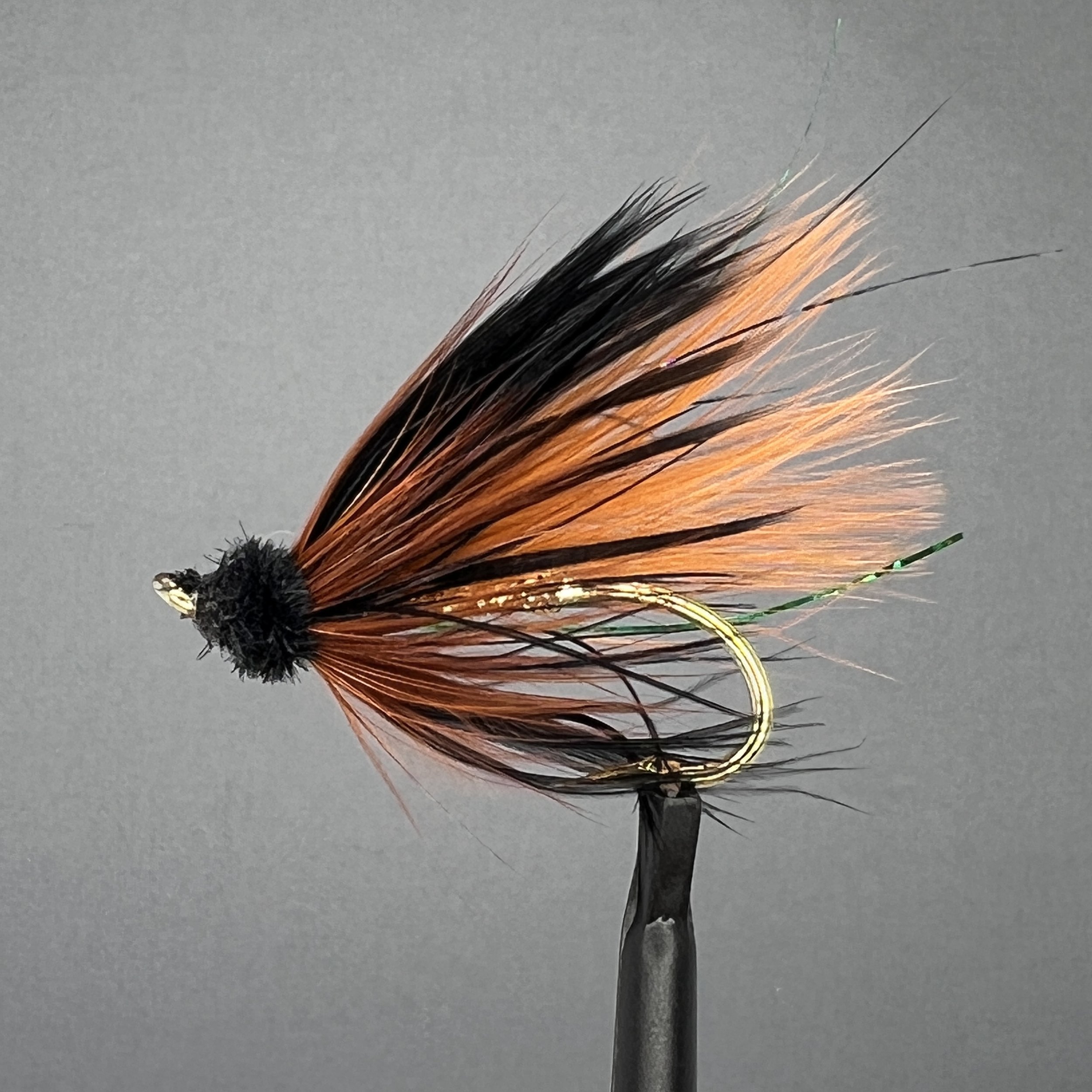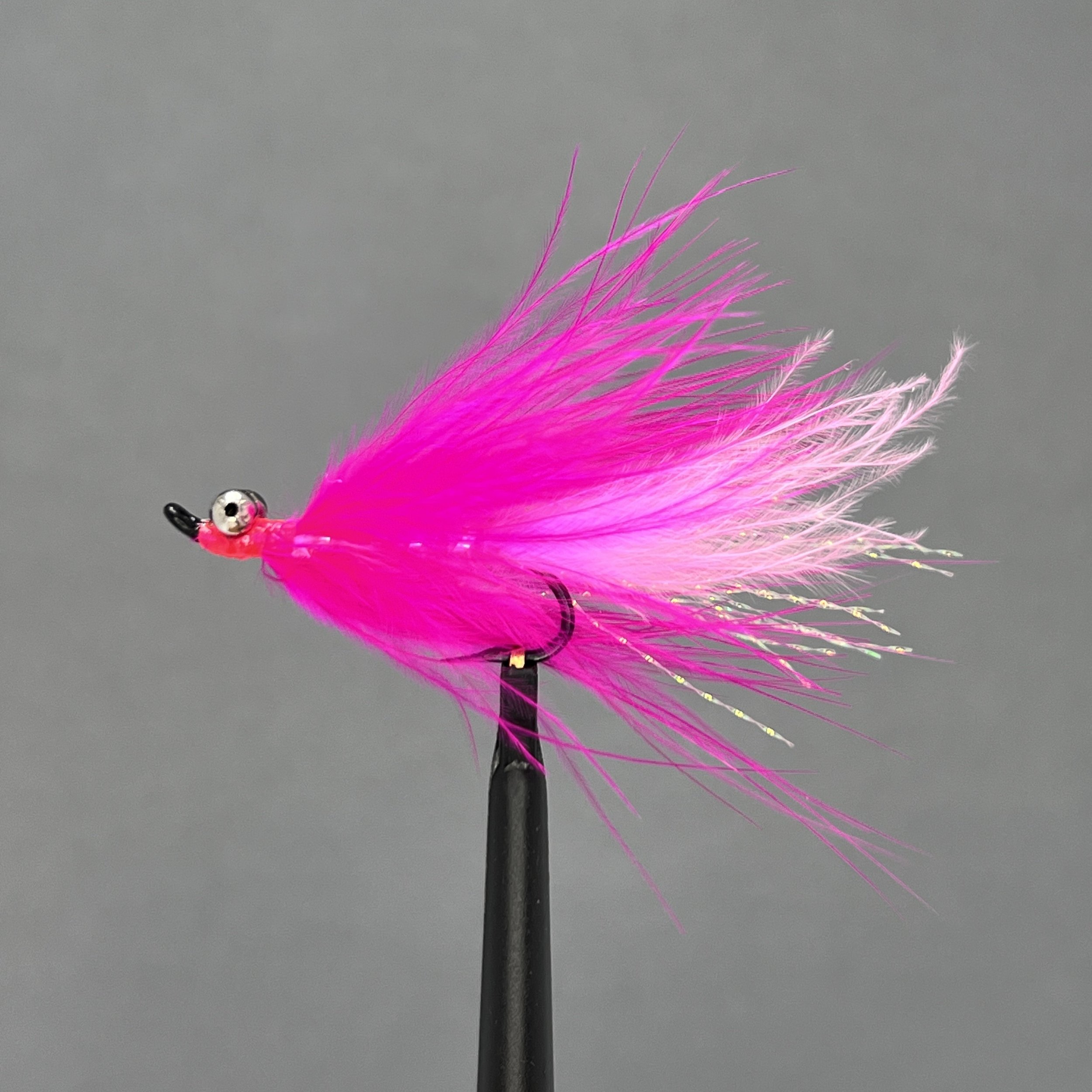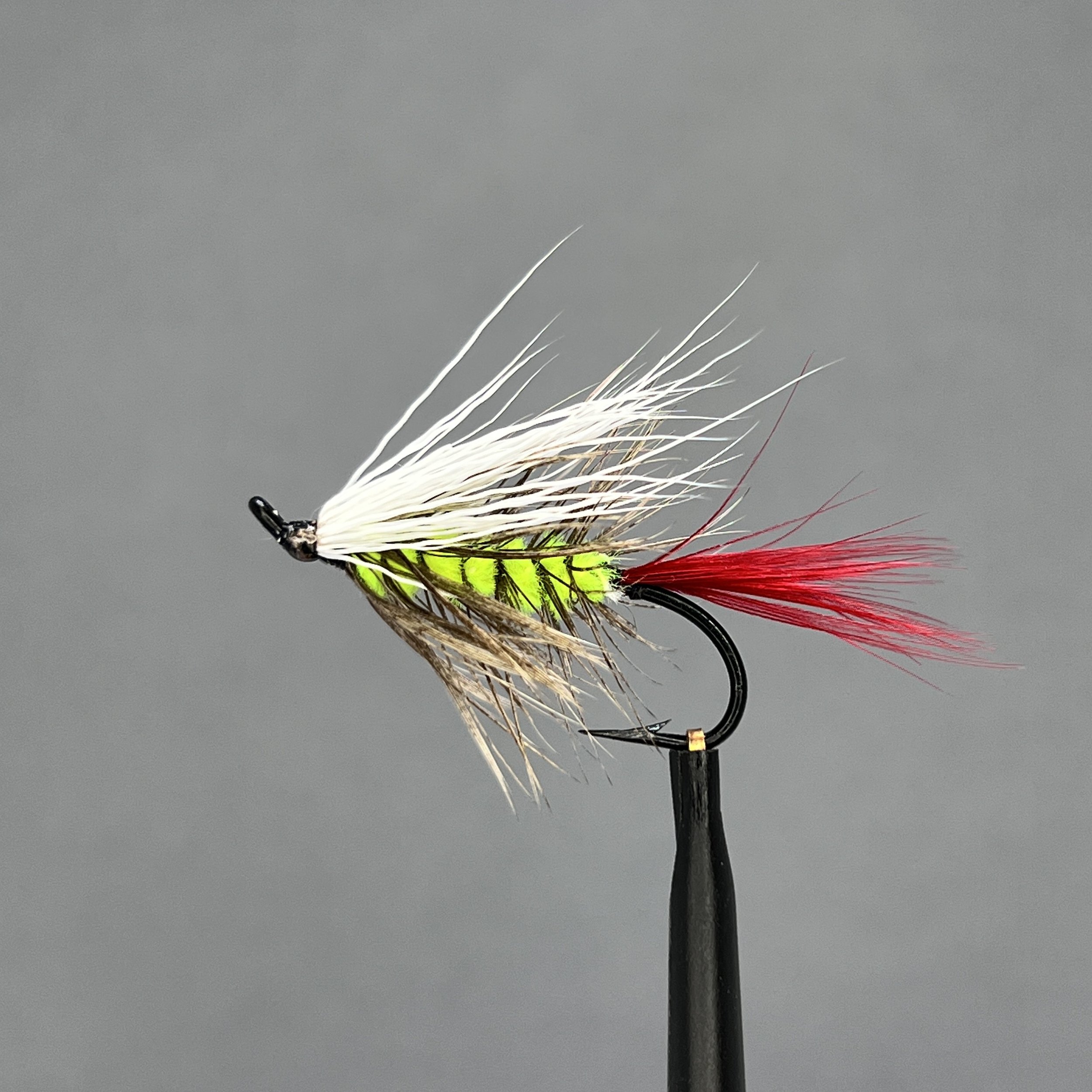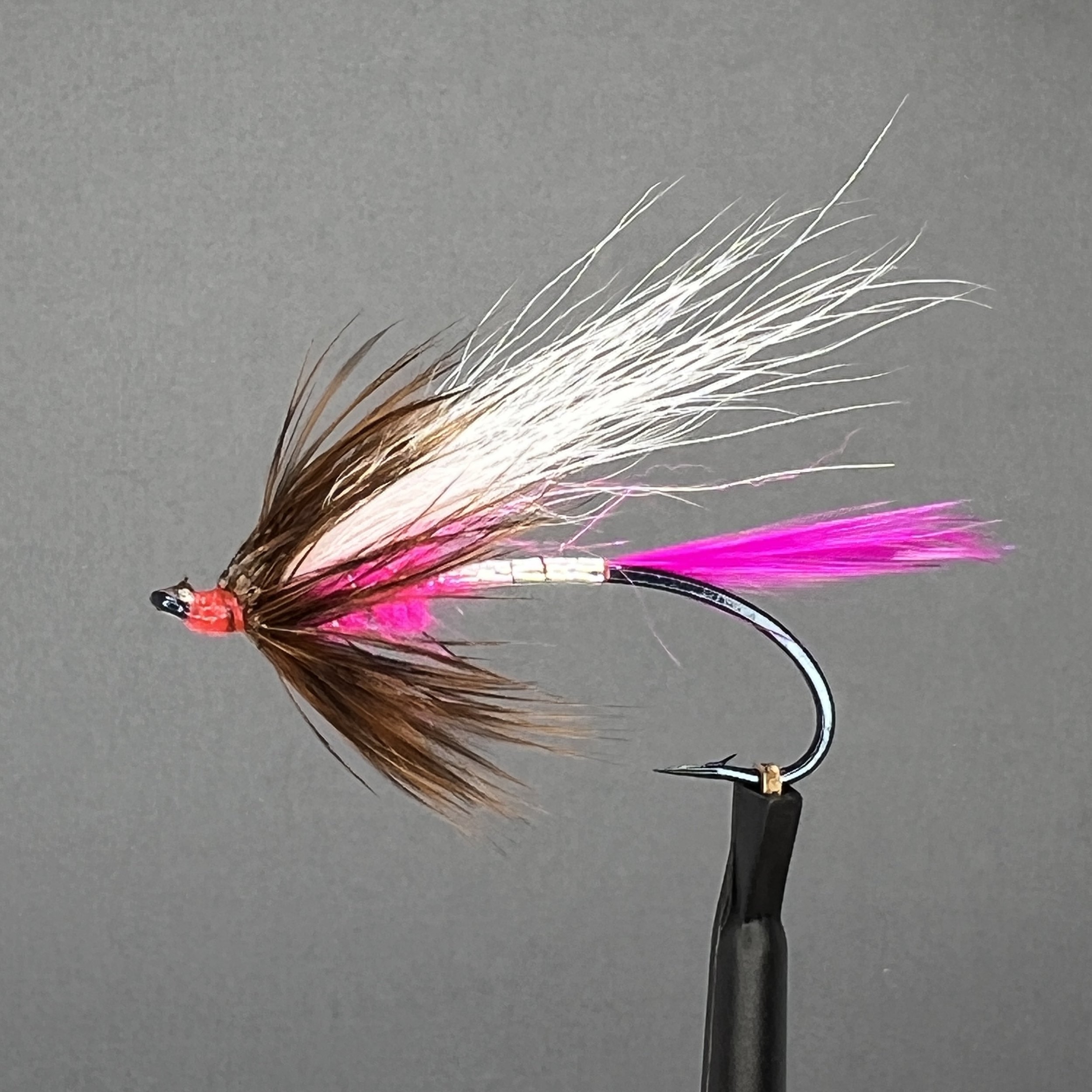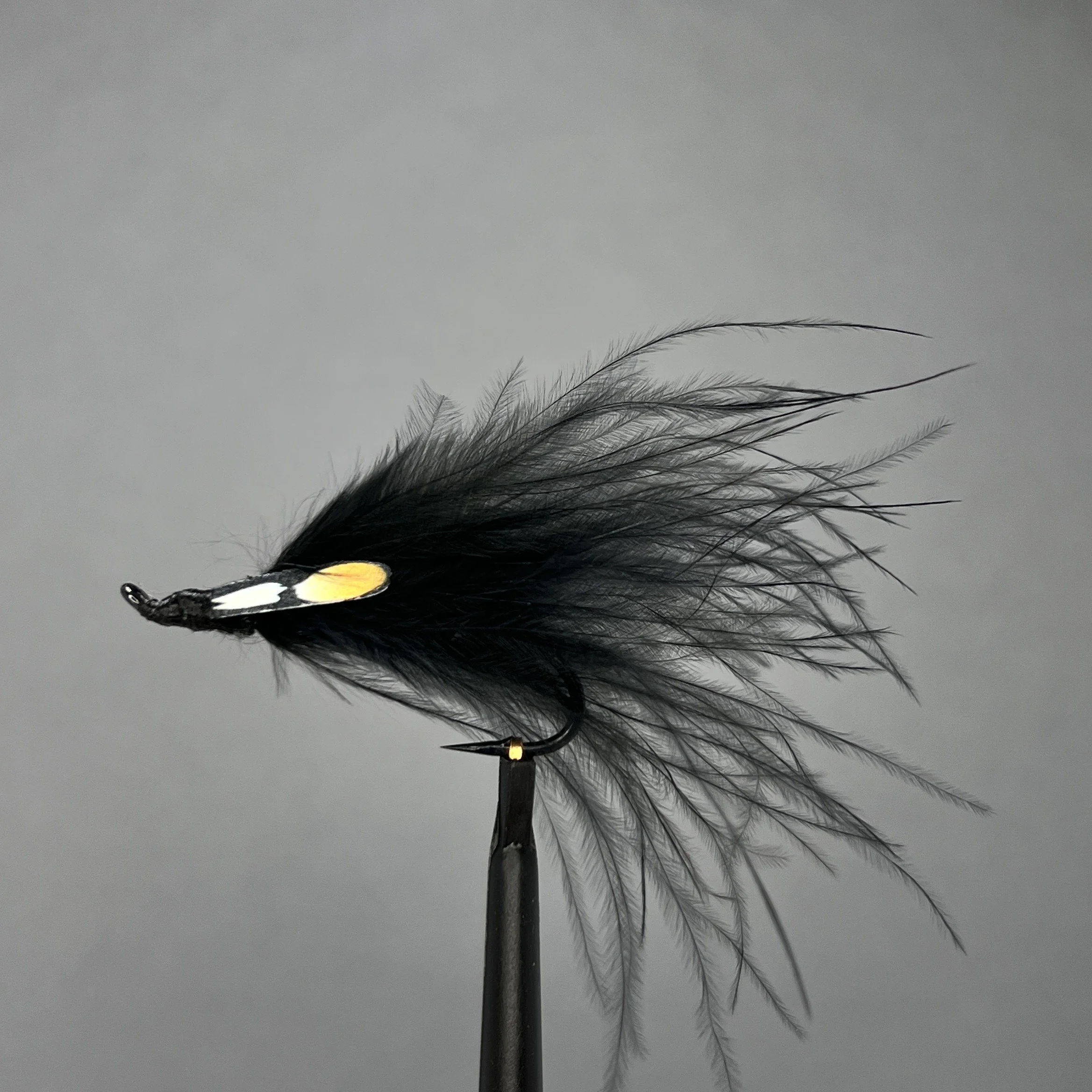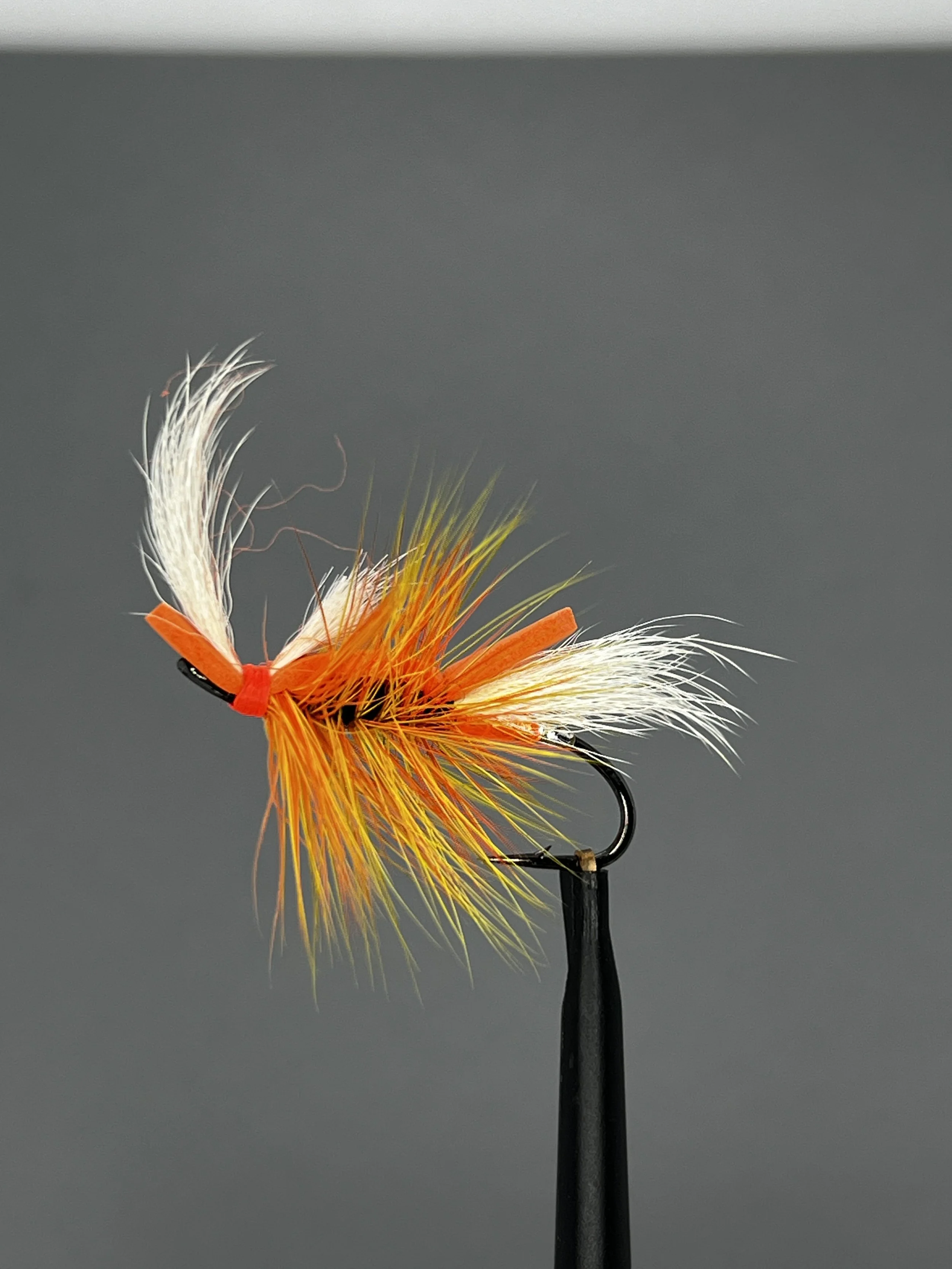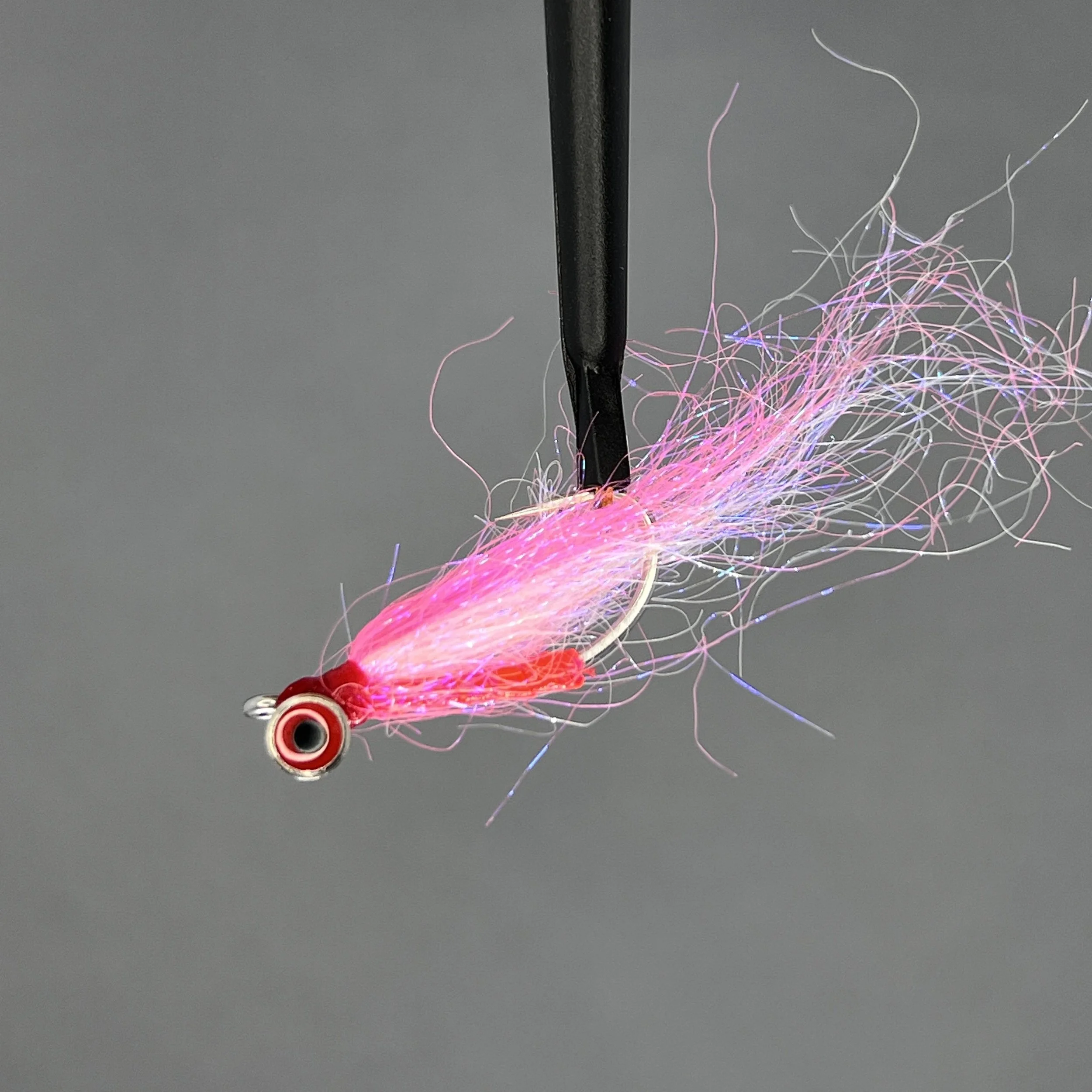FAVORITE PATTERNS OF CLARK-SKAMANIA FLYFISHERS
Steelhead and Salmon Flies
Forrest Koponen
Bucktail Belle
#4 Steelhead
Hook:
Black Uni, 6/0
Thread
Red hackle fibers
Tail:
Yellow floss
Body:
White and red bucktail
Wing:
Medium silver tinsel
Rib:
White and red tied as a throat
Hackle:
Peacock herl
Butt:
Notes: #1 Put three layers of floss on the body. Tie the floss at the back end then wind the thread to the front end of the body. Wrap the floss back and forth three times then tie off. #2 The portions of deer hair will stack up better if you put a wrap around each before you tie it down. Be careful to keep it centered.
Craig Lynch
Craig’s Comet
#8 TMC 7999 Steelhead or equivalent
Hook:
Thread:
Black Uni, 6/0
Black squirrel, bear or kip tail; 1.5X shank length
Tail:
Aft half any silver tinsel; front half seal or equivalent
Body:
Black saddle tied in at tip and folded
Hackle:
This is my go-to steelhead and Coho fly and has been, since about 1972. I used it when I lived on Kodiak Island and have fished it from California to British Columbia. It is very simple, can be lead-weighted if desired and it holds together after multiple fish. Additionally, it casts well in serious wind and it gets down through the water column well.
Craig’s Orange Comet
Craig Lynch
#4 gold salmon hook
Hook:
Red Uni, 6/0
Thread
Orange kip tail; 1.5X shank length
Tail:
Aft half any gold tinsel; front half fine red chenille
Body:
Orange saddle hackel
Hackle:
Red thread
Head:
Bill Koran
Disco Muddler
Lightweight Spey, e.g. Partridge Bartleet or Daiichi Alec Jackson
Hook:
Orange Flat Waxed Nylon
Thread:
Gold Mylar Tinsel
Body:
Dark Turkey Primary (Muddler version) over Elk Hair over Orange or Gold Flashabou
Wing:
Spun Elk Hair
Head:
Elk hair collar
Hackle:
Notes: The wings are tied in just back of the long loop eye. The spun hair is on the loop. The last bunch of hair at the front it tied only on top of the hook, and not spun.
This pattern dates back 20-25 years. It started because I wanted something that would ride more lightly on the water than a Bomber yet stay on top reliably. I also wanted something that didn’t take as long to tie as spinning all the hair needed for a Bomber, yet I liked the spun hair.
My original orange head caddis I named Discomoecus, since it is kind of flashy yet was designed with the October Caddis in mind, which is genus Dicosmoecus. Usually we just call it Disco (forgetting there is a Disco Mouse pattern.) The muddler version then becomes a Disco Muddler. I now fish the Muddler version most often, reserving the smaller Disco Caddis for follow-ups.
A key point that I never see mentioned: For waker visibility, I like the orange head when downstream is away from the sun, and a dark head/fly when downstream is toward the light. On our generally west-running streams, this means orange at first light and dark at evening twilight.
Forrest Koponen
Easy Purple Peril
Your favorite #4 standard Steelhead hook.
Hook:
Black or purple Uni, 6/0
Thread:
Squirrel tail. Squirrel wing makes a fine tail but unlike bucktail it is solid not hollow. Use a drop of super glue to hold it in place.
Wing:
Purple Chenille or purple Antron dubbing
Body:
Medium silver tinsel
Rib:
This is a Spey hackle. Ringneck rooster rump feather is the easiest to find. Blue eared pheasant as well as purple dyed Golden pheasant or any spey style feather you may like
Hackle:
Purple saddle hackle
Collar:
Notes: Like most flies the Purple Peril has been revised and retied many times over. I like to add a spey hackle to most of my Steelhead flies, hence the spey feather.
The fly was designed by George McLeod in 1930. Over the years it has become one of the most popular flies in the NW. Very close to the Green Butt Skunk. I use it as well as many of the fishers I know. It's always been one of my favs.
Mike Butcher
Faux Vairon
#1-#8 TMC 7999 or equivalent
Hook:
Color should match general color of fly. either 6/0 or 8/0
Thread:
Metallic diamond braid. Generally silver, gold, or copper.
Body:
Underwing, a bunch of marabou. Overwing, a few strands of flashabou.
Wing:
Fine wire that matches braid. This keeps the body getting destroyed after one or two fish.
Rib:
Two contrasting hackles. Usually I match the general color pattern (black and orange, cerise and purple, etc)
Hackle:
Two or three turns of small chenille, again match the general color combination. Then whip finish your thread in front.
Head:
Notes: The fly is more a general style of tying than a particular color scheme. I'm not always precise on getting the chenille head proportions correct. Just try to keep it visible.
When I first started tying flies, around 1971 or 1972, someone told me to tie a muddler. Having no idea how to make the deer hair head and no YouTube in that era, I could not tie the head of a muddler. Being an inexperienced tier, I took some small gray chenille and made a poor facsimile of muddler with a chenille head. Ugly, but the dang thing caught fish. This was years before anyone had heard of an egg sucking leech. Many years later, in tent camp in Alaska, while tying up flies to support 4 anglers with minimal materials, I again turned to this head style. I tied it in a cerise and purple color pattern, and we slaughtered silver, pinks, chums, basically anything in the river. This fly has been killer for most any steelhead, salmon, or cutthroat application I've tried it. The samples submitted are the original pink/cerise and fall steelhead (black/orange) rendition. It can adapt to any color scheme you wish.
In Alaska, the fly was given the name "chupacabra" by a partner, but I told him it was just a fake muddler which I later gave a Gallic twist called 'Faux Vairon', literally "fake minnow".
Steve Jones
Humpy Chaser
#4-8 Salmon hook, long shank
Hook:
Hot pink, Danville 210
Thread:
Thread wrapped marabou to hook eye
Tail:
Hareline Florescent pink marabou with 4-6 strands Pink flashabou
Body:
Uni mylar #14 (1/32") silver
Rib:
Hareline Cerise marabou
Hackle:
Small nickel bead chain eyes
Head:
Notes: You can put flashabou in tail or beneath eyes. The fly fishes hook up, eyes down and creates an up/down motion when stripped on the swing. Vary size of eyes from small to large to enable you to fish deeper water when necessary.
The combo of pink and Cerise marabou in this fly mimics the small shrimp Pink Salmon feed on at sea.
Michael Golob
Kalama Special
# 4-8 Mustad 36890
Hook:
Black
Thread
Scarlet hackle fibers
Tail:
Yellow Wool Yarn Palmered with Golden Badger Hackle
Body:
White Bucktail
Wing:
Golden Badger
Hackle:
Black Thread
Head:
Notes: I have a cabin on the Kalama River and my goal is catch a wild steelhead on the Kalama River using this traditional pattern.
Mike Butcher
Lady Thor
#2-8 TMC 7999 or equivalent
Hook:
Pink or red, either 6/0 or 8/0
Thread:
Pink hackle fibers
Tail:
Back 1/2 to 2/3 silver tinsel or mylar, front half to front 1/3, cerise or hot pink dubbing. Comb out to your liking.
Body:
Kip tail or Arctic fox
Wing:
Fine silver tinsel
Rib:
Larger brown grizzly soft hackles.
Hackle:
Pink thread.
Head:
Notes: At times I've played with Krystal Flash as an underwing. Just try to keep the body more silver than dubbing. I shoot for 2/3 and 1/3, but after combing the dubbing, it makes that part more than 1/3.
In 1975, as a teenaged beginning steelhead fly fisher, I ran in to old time Clark Skamania member Dave Ulrich on the Washougal. On that day, Dave gave me a few flies. One of which was a variation of the classic "Thor" steelhead pattern. The only difference was the pattern Dave gave me had a body that was mostly tinsel and only a tiny part chenille. I happened to catch 4 steelhead on that fly before I lost it. I copied that pattern in a myriad of color combinations. The one I have added here, has probably been my most successful, but purple is also good. It is a very effective early summer steelhead pattern and holds it's own in winter too. I've tied it all the way down to size 10 for sea-run cutthroat trout.
Jim Unger
Night Train
TMC 7999 or equivalent
Hook:
Black Vevus
Thread:
Black yarn
Body:
Black marabou fibers
Wing:
Silver antron
Rib:
Jungle cock (synthetic)
Eyes:
Tying Instructions: Begin at eye of hook, lay a thread base to bend of hook and Tie in 4 inch strand of Silver Antron followed by 4 inch strand black yarn. Wrap thread forward to eye and let hang. Next, wrap yarn to within 1/4 inch of eye leaving room for long head tie off and trim. At bend of the hook twist Antron yarn to smaller thickness and wrap a tag just to rear of black yarn, then spiral forward for 5 ribs. Tie off behind eye at same place as black yarn and trim. On top, where yarn and rib end, for ‘wing’, tie down a small clump of black Marabou fibers, clipped from the quill, and stroked back, just past bend of hook. Finally, just behind eye of hook, either side of the ‘wing’, tie a matching pair of synthetic jungle cock eyes on either side. Whip finish and done!
Tying Notes: Why do I say ‘Wing’ with quotes? Because on streamers for imitating things that swim , wings mean nothing. But something streaming in the right place resembling the Dorsal Fin , does mean something. Something like a Dorsal will look more natural to predators, and , thus, more enticing. That also is why I prefer long heads on my streamers looking more the shape of a fish’s nose, ahead of the eyes and Dorsal.
Jim Hutchison
Steelhead Skater
#4, TMC 7999 or equivalent
Hook:
White deer or calf tail, fine
Tail:
Orange either 6/0 or 8/0
Thread:
Front half black floss; aft orange floss; 2mm orange foam overbody
Body:
White deer hair or calf tail
Wing:
Silver tinsel
Tag:
Orange and yellow saddle hackle palmered over black floss body
Hackle:
Notes: This is not a "named" steelhead skater, just one I concocked about 2005 out of available tying material. Since then I've had some success with it on the North Umpqua, Deschutes, Grande Ronde and Snake rivers. As with other skaters, it has probably generated more big splashy misses than successful grabs. But cast again, same spot!
Steve's Pink Panther
Steve Aguilu
# 4 or # 2 (1/0 occ.) Daiichi 2546 or similar stainless steel O'Shaughnessy straight-eye saltwater hook
Hook:
Red Uni-Thread 3/0 for smaller, BigFly for 1/0 hooks
Thread:
Hairline Edge Brite, Hot Pink (Var: Hot Orange, Fluoro Green, Blue)
Body:
Hairline Ice Wing Fluoro Hot Pink over UV Mother-of-Pearl white: tied hook upward
Wing:
Spirit River Real-Eyes Plus with Red (Var: White) iris/black pupil
Head:
Notes: Eyes are tied on back top of hook. Fill in about 50% of the space around the center of the barbell eye and seal it with Loon Thin UV fly finish (Flow works well too if you want some shine). Lay the Edge Brite sheet on a cutting board and use the metal "ruler" from a carpenter's square. Use a #10 scalpel or very sharp Exacto knife to cut the material into very parallel and uniform 1/8" to 5/16" strips. Do an angled snip on the tip of the Edge Brite so that it turns and lies flat. Wrap it on the hook so that about 1/2 of the Edge Brite overlaps the previous turn.
This fly has landed me over 200 pink salmon in both fresh and salt water. Until now it has not had a name but thinking about the materials gave me the idea. If you know the story of the pink panther diamond (You should google "Inspector Clouseau" played by the great Peter Sellers) it is a real diamond that sold in 2017 for $ 71 Million and has a faint translucent pink tint with highlights of silver and pearl. Google a pic of that diamond and you will have an idea of the wispy translucence that makes this such an effective fly.
In addition, the overlap of the Edge Brite provides a vivid "tail-light" effect that brings the hard strikes. When you finish it, hold it up to the light sideways, then turn it and look from the tail end. You will see what I mean.
I have fished every odd-year pink salmon run since 1995 when I accidentally caught one fishing for sea run cutthroat standing on the tip of Kayak Point in the Port Susan region of Puget Sound. My favorite place to fish for them is along the shores of the Sound or just upstream of their entry into fresh water as they stack up in pools below sandbars and river-bends during outgoing tide. At that point, most of the males have not "humped" and they look and act like small silvers.
Just wait for the "yumpin humpies" to show themselves as they cruise along the shoreline (theory has it that they navigate by occasionally jumping out and checking their position, not sure I believe that one) or anchor your boat out in their pathway and you will pick up at least one or two fish from every pod that goes by. Often, you can see one of them turn out of the school and chase your fly. It is a blast. My best three days saw 72 fish to hand (and released!).
© 2025 Clark-Skamania Flyfishers PO Box 644 Vancouver, Washington 98666 info@csfly.net
